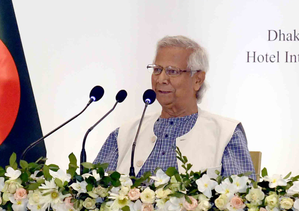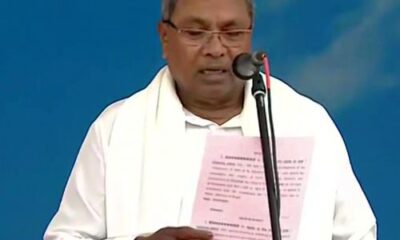International
London plans future flood defence as Thames Barrier turns 40
London, May 8 (IANS/DPA) Flood defence walls through London will need to be half a metre higher in the future to protect against climate change, officials said as they marked the 40th anniversary of the Thames Barrier.
The barrier, officially opened by Queen Elizabeth II, on May 8, 1984, and operated by the Environment Agency, was designed to protect London from flooding until 2030, but the “sleeping giant” is now expected to function until 2070.
The structure took eight years to construct, at 535 million pounds ($668 million) — 2.4 billion pounds in today’s money — and consists of 10 steel gates, with the main gates each as wide as the opening of Tower Bridge, weighing 3,300 ton, and as high as a five-storey building when raised.
Since its construction, it has been closed 221 times to prevent flooding of the capital, working with other flood defences along the Thames to protect 1.42 million people, residential property worth 321 billion pounds, hundreds of schools, hospitals, railway and train stations, and four World Heritage sites.
Without the barrier, officials said storm surges and frequent tidal flooding of the Thames would submerge buildings along the river — with only the city of London itself standing on high ground — risking lives and livelihoods and causing huge amounts of damage.
In the absence of the barrier, which is downstream from Greenwich and close to the city airport, the flood defence walls that line the Thames through central London would have to have been built up by another three metres, cutting off the city from its river.
However, with sea levels expected to rise by a metre by 2,100, along with increasingly intense storms driven by climate change, officials say that greater defences against flooding will be needed in the coming decades.
These include raising the flood walls and defences that line the Thames downriver of the barrier by half a metre by 2040 and then by the same amount by 2050, to the west, through central London.
A decision will need to be made by 2040 on what to do with the barrier itself, with options, including upgrading the existing barrier by 2070, so that the gates are not overtopped by rising seas and storm surges or installing a series of flood storage “reservoirs” downstream.
The other options are a new barrier with a similar design to the current one, which has moveable gates that lie flat on the riverbed when not needed to allow vessels to pass through and then swing up to close, or a permanent barrier with locks for river traffic.
The 40th anniversary also marks the final day in the job for Andy Batchelor, who has been the Thames Barrier’s manager for 25 years, having started a new job at the site on the day it was opened by the late Queen.
Batchelor said: “Having witnessed and worked on the Thames Barrier’s opening, I am immensely proud of the protection it has provided London for the past 40 years and will continue to provide for years to come.”
“Its reliability and effectiveness demonstrate the sophistication of its design by a very talented group of engineers and the continued maintenance and operation carried out by the Barrier team,” he added.
He said of the barrier: “It’s like the sleeping giant, it rolls into action, it wakes up when that is needed.”
“We have to maintain the giant in the background all the time,” he added, paying tribute to his team, who have a rolling programme of proactive maintenance, and routine closures, to keep the barrier working.
While the barrier has met the challenge it was designed for — including rising sea levels factored in before climate change was part of the conversation — the winter of 2013/2014 was extremely difficult.
Storms and weeks of heavy rain bringing high river flow down the Thames meant the barrier was closed 50 times in 13 weeks, including 20 closures on consecutive high tides.
If that intense use were to be replicated more frequently, it would not leave time for the maintenance the barrier needs to ensure it works when required.
So under the Thames Estuary 2100 plan by the Environment Agency and partners, the walls and defences that line the Thames will be raised by half a metre over the coming decades, which will allow the barrier to continue working for as long as possible.
Batchelor added that despite the success in protecting London over the past 40 years, the Environment Agency “will not rest on our laurels given the threat of rising sea levels” and would work with partners to review and decide on the right option for a new barrier by 2040.
–IANS/DPA
sd/khz
International
Lee Hsien Yang seeks refuge in United Kingdom

Lee Hsien Yang, the youngest son of Singapore’s founding father, the late Lee Kuan Yew, announced on Tuesday that he is now a political refugee in the United Kingdom after seeking asylum from the British government “as a last resort.”
“I remain a Singapore citizen and hope that someday it will be safe to return home,” Lee stated in a Facebook post, as reported by Channel News Asia (CNA).
Citing what he described as the Singapore government’s “attacks” against him, Lee, who is the younger brother of former Prime Minister Lee Hsien Loong, revealed that he sought asylum protection in 2022.
Lee Hsien Yang and his late sister, Lee Wei Ling, who passed away earlier this month, have been in conflict with their brother Lee Hsien Loong over the fate of their father’s home following his death in 2015, resulting in a public dispute that has estranged the siblings.
In an interview with the UK-based newspaper The Guardian, Lee alleged that a “campaign of persecution” compelled him to seek asylum in Britain.
In response to his claims, the Singapore government stated that there is “no basis” for his allegations of “a campaign of persecution” or other assertions regarding political repression in the country.
“Singapore’s judiciary is impartial and makes decisions independently. This is why Singaporeans have a high level of trust in the judiciary,” a government spokesperson remarked.
The spokesperson added that there are no legal restrictions preventing Lee and his wife, lawyer Lee Suet Fern, from returning to Singapore. “They are and have always been free to return to Singapore,” the spokesperson said.
Lee and his wife have been outside of Singapore since 2022, having opted not to attend a scheduled police interview regarding potential offenses related to providing false evidence in judicial proceedings concerning their father’s will and the family home.
Lee and his late sister, who had been living at the property, alleged they felt threatened while trying to fulfill their father’s wish to demolish the house. They also accused their elder brother, former Prime Minister Lee Hsien Loong, of abusing his governmental influence to advance his personal agenda.
International
Indo-Russian ties are stronger than ever before at BRICS

Kazan, Russia: Prime Minister Narendra Modi held a bilateral meeting with Russian President Vladimir Putin on the sidelines of the 16th BRICS Summit.
During the meeting, President Putin remarked, “I recall our meeting in July, where we had productive discussions on various issues. We’ve also spoken over the phone several times. I am very grateful you accepted the invitation to come to Kazan. Today, we will attend the BRICS Summit’s opening ceremony, followed by dinner.”
PM Modi responded by expressing his appreciation, saying, “I sincerely thank you for your friendship, warm welcome, and hospitality. It’s a great pleasure to visit such a beautiful city as Kazan for the BRICS Summit. India shares deep historical ties with this city, and the opening of our new embassy here will further strengthen these connections.”
International
Laos seeks to enhance nutrition amid climate change concerns

Vientiane (Laos), Aug 22 (IANS) Representatives from the Lao government and development partners have attended a conference here titled “Climate Change and Nutrition in Laos: Intersections and Interventions” to discuss the impact of climate change on nutrition in the Southeast Asia country and potential solutions.
Speaking at the conference, deputy director general of the Department of Hygiene and Health Promotion under the Lao Ministry of Health Viengkhan Phixay, said, “We gather to address a critical and interwoven issue: the impact of climate change on nutrition and how we can work together to tackle these challenges,” Xinhua news agency reported.
The Lao government is actively engaged in this endeavor, with numerous policies and initiatives aimed at addressing both climate change and nutrition, Lao National Television reported on Thursday.
“By leveraging the Scaling Up Nutrition network in Laos, which is led by the government, and supported by civil society, donors, and the United Nations, we have a robust platform to tackle the negative impacts of climate change while improving nutrition and overall health for everyone in Laos,” Viengkham said at the conference held on Monday.
The conference featured a series of presentations that not only detailed evidence-based research but also introduced innovative tools for measuring and enhancing nutrition under the impact of climate change.
The conference stressed the critical need for integrated approaches to tackle the intertwined challenges of climate change and nutrition, and setting the stage for impactful future collaborations.
–IANS
int/psd
International
One killed, seven injured in shootout in Iraq

Baghdad, Aug 22 (IANS) A civilian was killed while seven others were injured on Thursday in a tribal shootout in Iraq’s holy Shiite province of Najaf, according to a local security source.
The shootout erupted in the early hours between armed men from the local tribe in the al-Zarga area in northern Najaf, some 160 km south of Baghdad, a local police officer told Xinhua on condition of anonymity.
The clash resulted in the killing of an Iraqi civilian and the injury of seven others, including three Iranian Shiite pilgrims, the source added.
A joint force from the Interior Ministry’s emergency response division and Najaf provincial police arrested 53 gunmen from both sides of the shootout and seized weapons and ammunition, the Interior Ministry said in a statement.
It added that search operations are ongoing to locate additional gunmen and weapons, with more details to be released later.
The incident took place as numerous pilgrims traveled to the city of Karbala to observe Arbaeen, which marks the end of a 40-day mourning period for the killing of Imam Hussein, the grandson of Prophet Muhammad, in the Battle of Karbala in 680 A.D.
Typically, these pilgrims also visit Najaf as part of their journey to Karbala.
–IANS
int/jk/arm
International
Bangladesh seeks $1 billion budget support from World Bank

Dhaka, Aug 22 (IANS) Bangladesh’s interim government has sought $1 billion from the World Bank as budgetary support.
The call came from the country’s Power, Energy and Mineral Resources Adviser Muhammad Fouzul Kabir Khan’s meeting with Abdoulaye Seck, the World Bank’s Country Director for Bangladesh and Bhutan, in Dhaka on Wednesday.
He made the plea as the ministry owes more than 2 billion dollars to suppliers in import costs of power and energy, Xinhua news agency reported.
Khan mentioned that the interim government, which was formed with many pressing mandates, is due to settle a $2 billion debt left by the previous government in the power sector.
He said they have already suspended activities under the much-criticized Quick Enhancement of Electricity and Energy Supply Act 2010 and abolished the government’s power to set energy prices without any public hearing.
On August 5, the former Prime Minister of Bangladesh, Sheikh Hasina, was ousted from her country and power, ending her rule since January 2009.
This event was seen as a massive escalation, with what initially started as student’s protests and resulted in a major crisis in Bangladesh.
Earlier on August 8, Nobel laureate Muhammad Yunus took oath as the head of Bangladesh’s interim government.
–IANS
int/jk/as
-
Video2 years ago
PM Modi Attacks Congress in Karnataka with “Kerala Story”
-
Politics2 years ago
Siddaramaiah & DK Shivakumar sworn in as Chief Minister & Deputy CM respectively
-
Cricket2 years ago
CSK players rejoice 5th IPL title with their families (Pics)
-
Entertainment2 years ago
Karan Deol weds his longtime Girlfriend Drisha Acharya (Pics)
-
Sports7 years ago
History Of Official FIFA WORLD CUP Match balls
-
India2 years ago
Ashwini Vaishnaw: Railway Board recommends CBI probe in the Odisha railway disaster
-
Entertainment2 years ago
Urvashi Rautela dazzles on Cannes 2023 red carpet (Pics)
-
Entertainment2 years ago
Sunny Leone gets ready for Kennedy premiere in Cannes (Pics)





























